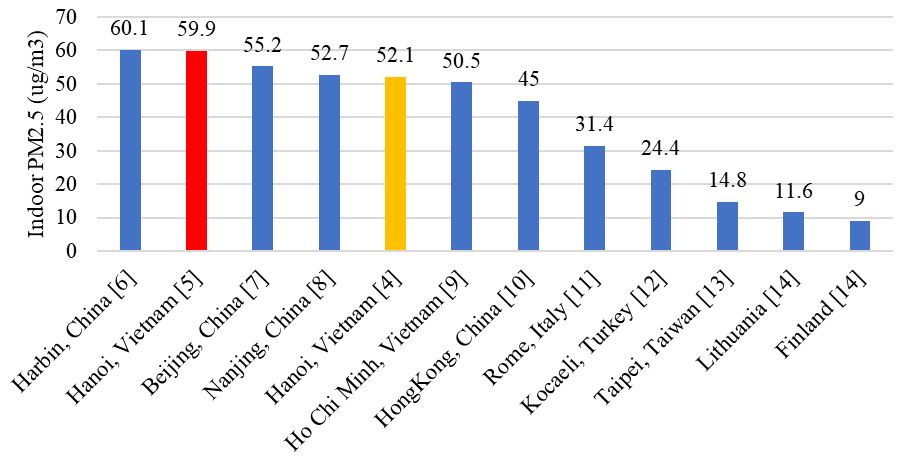Indoor PM2.5 concentrations in residential houses and influencing factors in Hanoi, Vietnam
Author: Dat Mac Van - Hanoi University of Civil Engineering
What is PM2.5?
PM2.5 refers to fine particulate matter with a diameter of 2.5 micrometers or smaller. PM2.5 can penetrate deep into the lungs, irritate and corrode the alveolar wall, and consequently impair lung functions and even cause lung cancer [1], [2], [3]. People spend about 90% of their time in indoor environments (in houses, offices, schools, etc.), and therefore, indoor PM2.5 may directly affect human health. In this post, we will explore indoor PM2.5 concentrations in houses and the factors that influence indoor PM2.5 levels in Hanoi, Vietnam.
Indoor PM2.5 concentration in houses in Hanoi, Vietnam
In Vietnam, air pollution has become increasingly severe in recent decades, particularly in major cities like Hanoi, where there has been a rise in concentrations of fine particle matter such as PM1.0, PM2.5, and PM10 [4], [5]. In Hanoi, a study showed that mortality attributable to long-term exposure to PM2.5 was 34.3 per 100,000 population was higher than that in Bangkok with 21 per 100,000 population [6].
In a study with 32 urban residential homes, L. K. Tran et al. [7] reported that the average indoor PM2.5 levels in Hanoi (52.1 μg/m3) were about 3–5 times higher than those measured in the Western countries’ homes and Taipei. But the figure was similar to other cities in Asia such as Nanjing (China), Sari (Iran), and Ho Chi Minh (Vietnam) (Figure 1). In most monitored homes, the indoor PM2.5 concentrations exceeded the WHO guideline (15 μg/m3). Over 47 % of the homes had a daily average indoor PM2.5 concentration greater than 50 μg/m3, the recommended guideline in Vietnam. In another study, Vo et al. found that the average concentration of indoor PM2.5 measured in the three dwellings was 59.9 μg/m3 which is approximately four times higher than the WHO guideline [8]. Thus, we can see that indoor PM2.5 concentrations in households in Hanoi were at high levels. What are the causes that affect PM2.5?

Factors that can affect levels of indoor PM2.5
- Outdoor PM2.5 concentrations: Outdoor PM2.5 pollution sources, such as traffic emissions, industrial activities, wildfires, and straw burning, can infiltrate indoor environments through ventilation systems, windows, and doors.
- Indoor sources: Indoor activities like cooking, smoking, burning candles or incense can release PM2.5 particles directly into the indoor air.
- Occupant activities: Human activities and behaviors within indoor spaces, such as cooking frequency, use of heating appliances, and smoking habits, can contribute to indoor PM2.5 concentrations.
- Ventilation and air exchanger: the rate of ventilation and air exchange within a building can significantly influence indoor PM2.5 concentrations. Poor ventilation can lead to the accumulation of pollutants indoors, while proper ventilation can help dilute indoor pollutants.
- Filtration and air cleaning devices: The presence and efficiency of air filtration systems and air purifiers can affect indoor PM2.5 levels by capturing and removing particles from the air.
- Other: Factors such as building age, construction materials, insulation, and airtightness can impact indoor PM2.5 levels. Older buildings or those with poor insulation may be more susceptible to infiltration of outdoor pollutants.
Intervention to reduce PM2.5 in the houses:
- Open Windows: When outdoor air quality is good, open windows to allow fresh air to circulate. This helps dilute indoor pollutants.
- Avoid Smoking Indoors: Smoking is a major source of PM2.5 indoors. Ensure smoking is done outside, away from doors and windows.
- HVAC System Filters: Upgrade to high-quality filters in your heating, ventilation, and air conditioning (HVAC) system.
- Air purifiers: Use air purifiers equipped with HEPA (High-Efficiency Particulate Air) filters to capture fine particles. Place them in commonly used areas such as living rooms and bedrooms.
Each factor will have different effects on indoor PM2.5 concentrations. To quantify the influence of sources on indoor PM2.5concentrations, we need to conduct further studies.
Continue…
References
[1] F. Huang, B. Pan, J. Wu, E. Chen, and L. Chen, “Relationship between exposure to PM2. 5 and lung cancer incidence and mortality: A meta-analysis,” Oncotarget, vol. 8, no. 26, p. 43322, 2017.
[2] B. Yang, J. Guo, and C. Xiao, “Effect of PM2. 5 environmental pollution on rat lung,” Environmental Science and Pollution Research, vol. 25, pp. 36136–36146, 2018.
[3] Y.-F. Xing, Y.-H. Xu, M.-H. Shi, and Y.-X. Lian, “The impact of PM2. 5 on the human respiratory system,” J Thorac Dis, vol. 8, no. 1, p. E69, 2016.
[4] N. T. K. Oanh et al., “Particulate air pollution in six Asian cities: Spatial and temporal distributions, and associated sources,” Atmos Environ, vol. 40, no. 18, pp. 3367–3380, 2006.
[5] N. T. T. Thuy, N. T. Dung, K. Sekiguchi, L. B. Thuy, N. T. T. Hien, and R. Yamaguchi, “Mass concentrations and carbonaceous compositions of PM0. 1, PM2. 5, and PM10 at urban locations of Hanoi, Vietnam,” Aerosol Air Qual Res, vol. 18, no. 7, pp. 1591–1605, 2018.
[6] N. T. T. Nhung et al., “Mortality burden due to exposure to outdoor fine particulate matter in Hanoi, Vietnam: health impact assessment,” Int J Public Health, vol. 67, p. 1604331, 2022.
[7] L. K. Tran et al., “The impact of incense burning on indoor PM2. 5 concentrations in residential houses in Hanoi, Vietnam,” Build Environ, vol. 205, p. 108228, 2021.
[8] L.-H. T. Vo et al., “Indoor PM0. 1 and PM2. 5 in Hanoi: chemical characterization, source identification, and health risk assessment,” Atmos Pollut Res, vol. 13, no. 2, p. 101324, 2022.